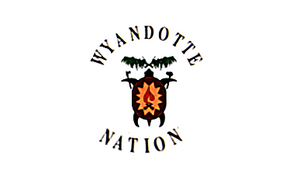Wyandot people facts for kids
 |
|
| Total population | |
|---|---|
| 5800 (2001) | |
| Regions with significant populations | |
| Canada – Quebec, southwest Ontario United States – Ohio, Oklahoma, Michigan, Kansas |
|
| Languages | |
| French, English, revival of Wendat | |
| Religion | |
| Animism, Roman Catholicism, Other | |
| Related ethnic groups | |
| Petun, other Iroquoian peoples |
The Wyandot people (also known as Wendats or Huron) are a group of Native Americans. They have a long and important history in North America. They lived near the Great Lakes in what is now Canada and the United States.
In the 1600s and 1700s, the Wyandot people were important traders. They traded furs with Samuel de Champlain and the French. They were friends with New France (the French colonies). They were also rivals with the Iroquois and the Dutch and English colonies.
Contents
Important Treaties and Land
The Wyandot people signed many agreements over time. One important agreement was the Treaty of Detroit. They signed this treaty on November 17, 1807.
Who Signed the Treaty?
The Wyandots signed the treaty with three other Native American tribes. These tribes were the Odawa, Ojibwe, and Potawatomi.
What the Treaty Meant
By signing this treaty, the tribes gave up large areas of land. This land was in what is now Michigan and Ohio. They gave these lands to the United States government.
Images for kids
-
Main body of Georgian Bay highlighted on the map of the Great Lakes directly above Lake Ontario, with its outlet on the Saint Lawrence River. This is where the Huron encountered the French.
-
Three Huron-Wyandot chiefs from the Huron reservation (Lourette) now called Wendake in Quebec, Canada. After their defeat by the Iroquois, many Huron fled to Quebec for refuge with their French allies, where a reserve was set aside for their use. Others migrated across Lake Huron and the St. Clair River, settling in the northern Ohio and Michigan region.
See also
 In Spanish: Pueblo hurón para niños
In Spanish: Pueblo hurón para niños






